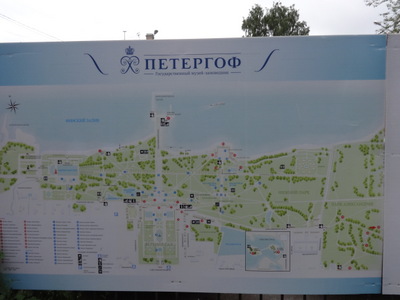
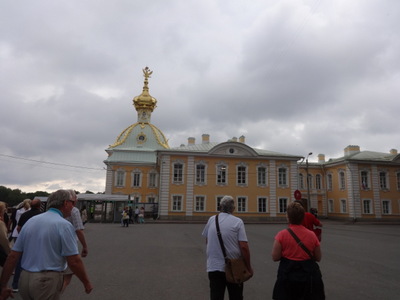 In 1710, Peter the Great traveled to France, saw Versailles, and came back wanting to copy it. The result was the Peterhof, our second of the three summer palaces in St. Petersburg: the Catherine Palace, the Peterhof, and the Pavlovsk Palace (built by Catherine the Great for her son, Paul I). These are the "big three" as listed by our tour escort; I'm not sure where that leaves the Alexander Palace that we saw through the fence next door to the Catherine Palace . . . .
In 1710, Peter the Great traveled to France, saw Versailles, and came back wanting to copy it. The result was the Peterhof, our second of the three summer palaces in St. Petersburg: the Catherine Palace, the Peterhof, and the Pavlovsk Palace (built by Catherine the Great for her son, Paul I). These are the "big three" as listed by our tour escort; I'm not sure where that leaves the Alexander Palace that we saw through the fence next door to the Catherine Palace . . . .
Anyway, the map at the left shows the palace grounds, 1500 acres along the Gulf of Finland. It consists of a formal (i.e., geometric) upper park, an informal lower park, and a spectacular collection of gravity-driven fountains fed from spring-fed holding ponds behind palace. The gravity-fed thing works because the whole property slopes downward toward the gulf, so the ponds are at the high point, then the palace, informal gardens below.
In the map above at the left, the rectangular section that juts downward just to the left of center is the formal garden, the palace extends east-west across the north end of it, and the portion we explored is north of that between the palace and th gulf (at the top of the map. The marked central axis from the palace to the gulf is the grand cascade.
After Peter built the palace, his wife (Catherine I) and daughter (Elizabeth I) expanded it to its present size (900 feet wide). Alexei described Elizabeth I as "the lady of baroque and glamour" and added that she left a lot of unpaid bills at her death to prove it.
Alexei also pointed out, more than once, that the water in the fountains is not recirculated. It flows from the spring-fed ponds down the hill, through the fountains, and all the way to the gulf, where it empties into the sea. Or, as he put it, "is wasted." Now it seems to me that those springs emptied into the sea long before anybody lived here, so running the water through aesthetically pleasing fountains on its way isn't any more wasteful than leaving it in its natural state. Not every last spring on earth needs to be drunk by people or turned into beer or vodka! I wince every time I think about that lovely Colorado mountain stream we saw disappear into the Coors plant, never to emerge (except on trucks).
Written 25 September 2017
The walk from the parking lot (where the legend is on the map) to the house led through a very large area occupied by rows and rows of neat and uniform gift shops. As we got to the building, viewed from one end, Alexei paused to point out the double-headed eagle atop the golden dome. He emphasized that at 11:45 a.m., when we were to meet back at the buses, we must walk toward that double-headed eagle. If we instead walked toward the dome topped with a cross, at the other end of the façade, we would never find the parking lot and might never be seen again.
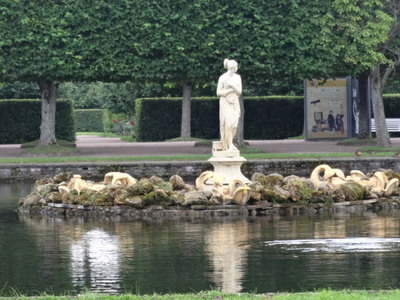
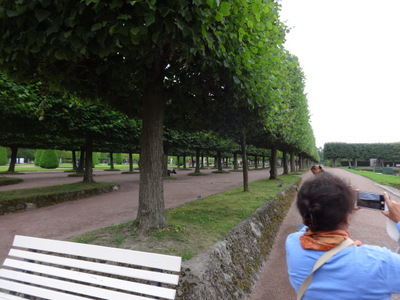 The French influence is definitely as you can see in the style of the statuary and the allees of trees trimmed to form elevated hedges. Once again, all of these were of linden, whereas many would have been of plane trees farther south.
The French influence is definitely as you can see in the style of the statuary and the allees of trees trimmed to form elevated hedges. Once again, all of these were of linden, whereas many would have been of plane trees farther south.
Written 26 September 2017

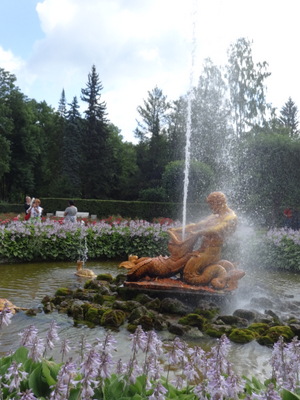 We walked around to the left, then along the facade to the center point to get this view down the "grand cascade." The fountains are no longer run all the time, because the water supply isn't sufficient, but every morning at the appointed hour, music is played, and the fountains are turned on for a period.
We walked around to the left, then along the facade to the center point to get this view down the "grand cascade." The fountains are no longer run all the time, because the water supply isn't sufficient, but every morning at the appointed hour, music is played, and the fountains are turned on for a period.
The fountains must be regilded every two years.
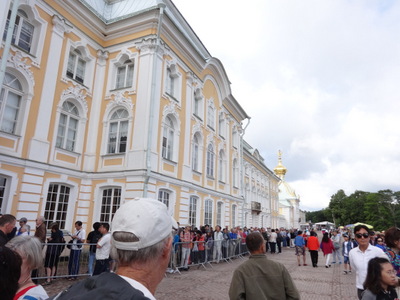
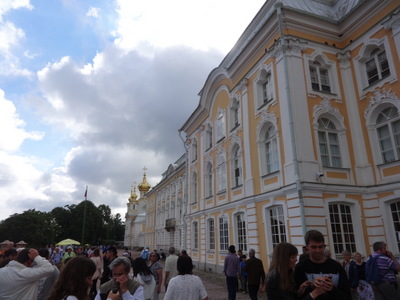 I couldn't get a photo of the whole 900-ft facade of the palace. To get the photo at the left, I stood at the midpoint and shot back the way we'd come. Note the long line of people waiting along the wall to go inside; between 9:15 a.m. and 12:15 p.m. each day, they get 7,000 people.
I couldn't get a photo of the whole 900-ft facade of the palace. To get the photo at the left, I stood at the midpoint and shot back the way we'd come. Note the long line of people waiting along the wall to go inside; between 9:15 a.m. and 12:15 p.m. each day, they get 7,000 people.
For the right-hand photo, I simply turned in place and shot westward, down the other half.
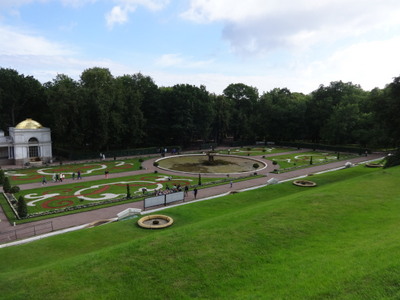
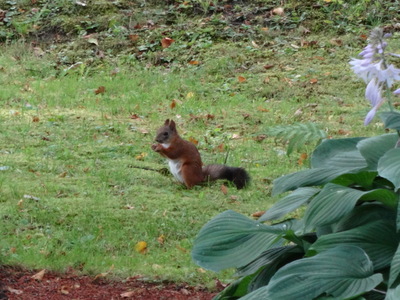 Still standing on the terrace in front of the palace and looking down the slope, I got this show of the small area of formal garden on the north side of the palace (most of the formal area is south of it). You can definitely see the influence of Versaille in the layout, although the plantings are not as well developed. In fact, at the Catherine Palace, many of the geometric designs were simply paved with colored stones to suggest contrasting vegetation.
Still standing on the terrace in front of the palace and looking down the slope, I got this show of the small area of formal garden on the north side of the palace (most of the formal area is south of it). You can definitely see the influence of Versaille in the layout, although the plantings are not as well developed. In fact, at the Catherine Palace, many of the geometric designs were simply paved with colored stones to suggest contrasting vegetation.
We walked a long loop through parts of the informal garden, starting to the west, then turning north, and finally back east again to the central axis to watch the fountain ceremony. One of the first things we encountered on our stroll was this large, cute red squirrel. I saw starlings and sparrows around the fountains and some swifts overhead in the gardens, but otherwise, wildlife was scarce.
Heaven forfend that the garden just be a garden. Through it, Peter scattered all sorts of special features. One was a fountain that looked like a small leafy tree. We passed it at a distance, so I couldn't see just how it was constructed, but I think all of it, trunk, branches, and leaves, was metal, and little jets of water all over it sprayed water so that it was wreathed in a perpetual shower.
Peter's sense of humor was reflected in another special feature, the trick fountain path. As guests or courtiers strolled through the shady gravel paths or paused for a rest or a chat on one of the many decorative benches, they could at any time be unexpectedly drenched by any of 300 small concealed fountains. I don't know whether they came on randomly, in some set pattern, or individually (controlled by an unseen observer), but I'm sure they were considered an absolute riot by silk-clad ladies with elaborate hair styles out for a stroll on a balmy 50°F day in May. We were assured that nowadays they are never operated before 1 p.m.
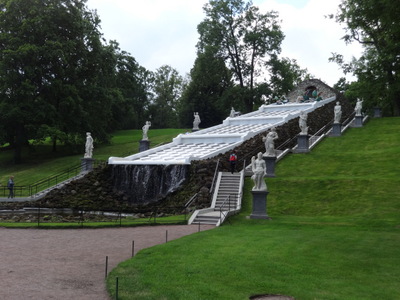
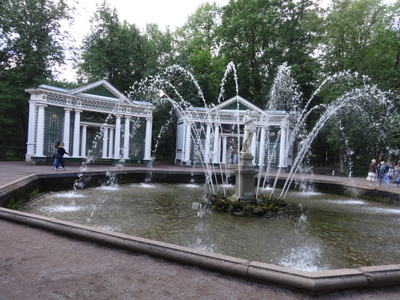
Here's the view back up one of the smaller cascades that flank the grand cascade. The decor is eclectic. Down the sides march classical white marble statues. At the top, the water source consists of three whimsical, cheerful, brightly painted winged dragons that spew water from their mouths.
At the right is another fountain we passed, playing even before the cascade was turned on.

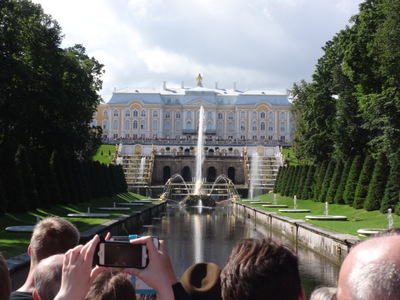 Here's the spot we chose to watch the fountains coming on. We're looking up the axis of the grand cascade (perhaps halfway down its axis) toward the palace.
Here's the spot we chose to watch the fountains coming on. We're looking up the axis of the grand cascade (perhaps halfway down its axis) toward the palace.
At the right, the process is about half complete, the central tall fountain hasn't yet reached its full height, nor have the small fountains in stone circles that line the banks of the central canal, and water hasn't yet started cascading down the steps to either side of the tall fountain.
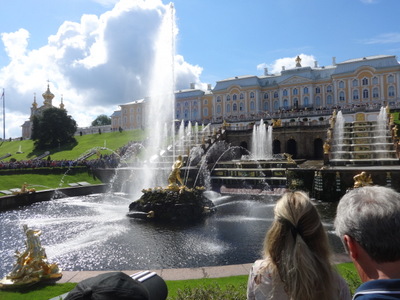
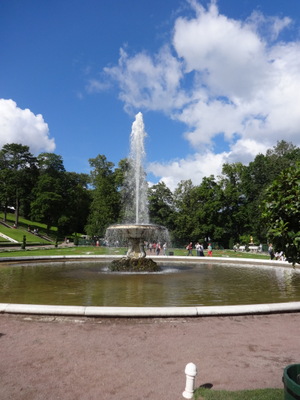 As the process continued, we strolled up the east side of the axis. By the time we reached the point where I took the left-hand photo, it was just about complete, except that the flow down the steps hadn't reached its maximum.
As the process continued, we strolled up the east side of the axis. By the time we reached the point where I took the left-hand photo, it was just about complete, except that the flow down the steps hadn't reached its maximum.
The first time we walked by it, the fountain at the right was just a large bowl, dripping a little water over the sides to moisten the moss at its foot. With the gravity feed turned on, it was quite an impressive jet.
Alas, no photos were allowed inside the Peterhof. We once again donned paper shoe covers on our way in. The palace was occupied by the Germans during World War II and was asheavily damaged as the Catherine Palace. Some of the restoration wasn't complete until the 1960's. Here are notes I took during the tour.
- The original two-story small rectangular building was designed by a German architect named Braunstein.
- The enemies Peter defeated to regain control of the St. Petersburg area were under Charles XII of Sweden.
- Golden rooms with frescos on the ceiling, beautiful parquet floors; moldings are carved and gilded linden wood.
- The second room, the larger, was called the ballroom or merchant's room. Its restoration was completed in 1962.
- Then a room with much less gold but lots of gilt and paintings of naval victories. Peter loved paintings of naval victories and commissioned dozens.
- The grand throne room is mostly green and white, with a dozen crystal chandeliers. Its bright red window treatments are heavy red-on-red damask with tassels and fringe. The equestrian portrait at the end of the room behind the throne is actually Catherine (Peter's wife), dressed as a man and riding astride. She knew she looked good in men's clothes and had herself painted that way several times. More naval battles on the wall.
- Gold and white room with red curtains and another fresco ceiling.
- A room designed by Francesco Restrelli, the Italian who did so much work for Catherine the Great. This room among the first to be restored. The Meisen figurines, decorative objects, and clock are original.
- The White Dining Room with two huge white-on-white tiled stoves, seafoam green trim, and white tables set with gorgeous Staffordshire china, commissioned by Catherine the Great. Standing candelabras with crystal drops on the table and matching chandeliers hanging from the ceiling. The table set for 22, and each plate rests on a shallow cylindrical china base that was probably a warmer filled with hot water.
- On the original throne of Nicholas the I; the large "H" on it stands for Nicholas.
- A tiny intermediate room was very dark, red, green, gold, and black, with Asian and Oriental objects and paintings and a different parquet.
- In Hall of Portraits, 324 portraits are placed edge to edge and completely cover the walls. Yanush, the artist, used only five models (chosen from among the palace servants) and painted them in different costumes and poses to produce all these portraits. The Russians, under Peter's influence, were getting used to the idea of hanging portraits on the wall, but they had only ever seen images arranged edge to edge to cover iconostases, so that's how they started out displaying them,.
- Another Asian room, same color scheme as the first.
- A music room with a harp and a recess with a sofa in it, some paintings.
- The Partridge room, a boudoir.
- The divan room, with a large, deep L-shaped day bed/sofa, another sofa in a recess; Asian tapestries or paintings on the wall.
- A room with dizzying floral and leafy wall-paper
- The empress's study has a porcelain chandelier, baskets of flowers on the wallpaper, a series of family portraits around the side, and a little secretary desk.
- The Standard Room was a small living room with green brocade wallpaper with pink roses.
- The Cavalier's Room had red brocade wall paper, a grandfather clock, and a blue and white Delft stove. A background of floral garlands on the wallpaper; handsome clock on tabletop.
- A dining room with a huge Delft stove in the corner. Gold and lapis lazuli chandelier with a zillion candles.
- A 1,000-piece china set, green cabbage leaf pattern (the largest ever produced in Russia?). Glass vases with fruit in them.
- A concert hall.
- A series of five small rooms in a row, called the "spare apartment." The Delft stove was about 7 feet tall.
- In the state bedroom, or "Crown Room," the original bed of Peter the Great, brought here from "Mon Plaisir" (i.e., "My Pleasure"), his other residence (which is on the Gulf of Finland, east of the main axis of the gardens), is way short. Peter was 6'8" and apparently slept sitting up in it. He must have considered that normal; otherwise, why didn't he just commission a bigger bed? Also, a stone-inlaid table.
- In the study of Peter the Great, the walls are all relief-carved oak; globe in the center, a huge desk and a secretary desk; library on the walls, including a mezannine level with concealed ladders that slide into slots in the door frame.
- Strangely, stuck in a corner somewhere along the way, I spotted a modern black steel torchère lamp in very much like the one by my bed in Tallahassee. I think I got it from the "discontinued" stock in a scandinavian furniture store that was closing down. I've never seen anthoerlike it.
- 150 gardeners now keep the gardens up; the orangerie is now a cafe (we saw no orange or other citrus trees; they now keep little bay laurels in pots to give the impression the original trees did).
- The blue and white chateau at the top of the hill belonged to the Benois family. The original Benois came as the Tsar's cook. His offspring because art collectors; hence the "Benois madonna" in the Hermitage.
- The monogram of the castle is PP, for Petrus Primus, Peter the First.

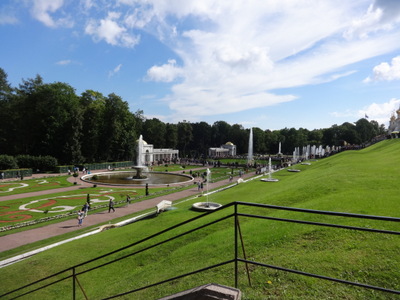 We had a little time before we had to be back on the buses, so we strolled by the fountains once more as we moved slowly back toward the parking lot.
We had a little time before we had to be back on the buses, so we strolled by the fountains once more as we moved slowly back toward the parking lot.
Then back up the iron-railed stair to the palace terrace and back through the collection of gift shops, where we found Rachel stocking up on beer mugs as gifts.
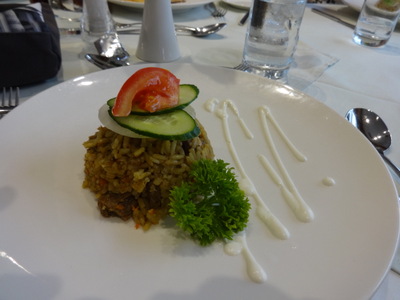
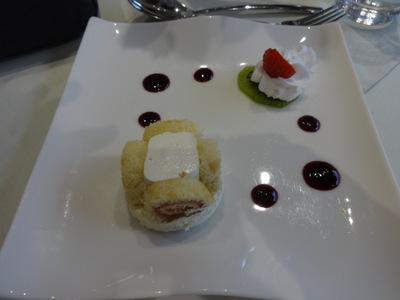 Back at the ranch (well, ship), the featured starters were "crisp potato fritters" and little dishes of grilled zucchini, eggplant, and bell pepper dressed with balsamic glaze. We'd had the fritters (actually more like thin potato pancakes) before, kept warm in a chafing dish on the buffet, and they were good, but in no way could they be called "crisp."
Back at the ranch (well, ship), the featured starters were "crisp potato fritters" and little dishes of grilled zucchini, eggplant, and bell pepper dressed with balsamic glaze. We'd had the fritters (actually more like thin potato pancakes) before, kept warm in a chafing dish on the buffet, and they were good, but in no way could they be called "crisp."
I think Rachel had the pumpkin curry soup for her main course, but I didn't get a photo. Ev may have had the Viking burger, hold the onion. I went straight for the regional specialty, "Uzbeck plow" (left). I was at first baffled by the name, until I realized that it is not a translation but a transliteration. "Plow" is cognate with pilaf/pilau/pulao—a sort of rice casserole, this one including lamb, vewgetables, and a rich stock. Drizzled with sour cream. It was great—another one I have to try at home. A little search on the internet revealed that it's usually spelled "plov" rather than "plow," making it more obviously cognate with "pilaf."
The pasta was Fusilli arrabiata, and I don't think anyone ordered it.
The dessert choices were "stracciatella" ice cream coupe, which we'd had before and was okay, but this time everyone ordered the carlotte russe (right-hand photo). Traditionally, a charlotte russe is cylindrical; lady fingers are stood in a palisade around the sides of the mold, and the center is filled with fruit and Bavarois (i.e., Bavarian cream, a sort of cross between panna cotta and cream and a long skinny jelly roll, then assemble slices of the two into the configuration you see here, all on a bed of whipped cream. Pretty good.
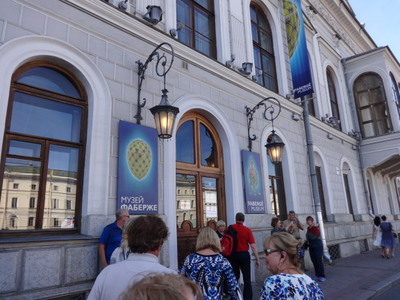
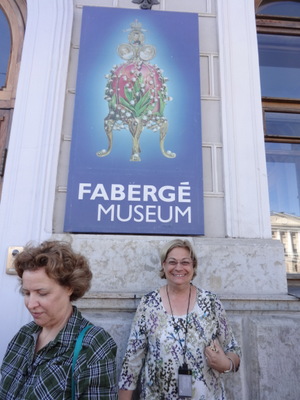 Our afternoon tour was of the Fabergé museum, which we chose over four other options: (1) the extended tour of the Peterhof, (2) a tour of St. Petersburg from the water, (3) a visit to one of the few remaining communal apartment dwellings in the city, and (4) a bus to the city center for three hours of free time.
Our afternoon tour was of the Fabergé museum, which we chose over four other options: (1) the extended tour of the Peterhof, (2) a tour of St. Petersburg from the water, (3) a visit to one of the few remaining communal apartment dwellings in the city, and (4) a bus to the city center for three hours of free time.
The Fabergé is the newest in the city, opened 2015 in the former Shuvalov Palace. Viking arranged to take us there on a day when it's normally closed, so we had the place to ourselves.
The house was founded by Gustav Fabergé, who left France in the early 19th century and wandered around for a while before setting in Pärnu, Livonia (now Estonia). He left there in 1842 and settled in St. Petersburg, where he prospered.
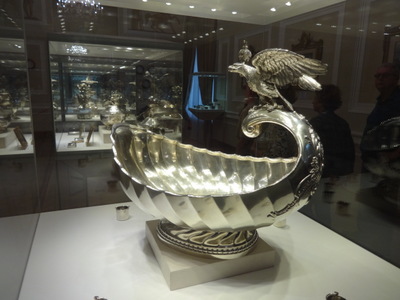
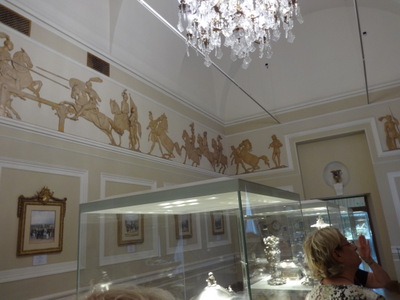 The museum houses the world's largest collection of Fabergé's work (and that of his workshop and his offspring). The exhibits are beautifully laid out, in four-sided individual vitrines so that you can walk all the way around them to see both back and front. They're uncluttered by labels; each piece is marked by a small number. At the door, you can pick up a book (in any of several languages; I chose English) that gives full info about each piece; you look them up by room and item number.
The museum houses the world's largest collection of Fabergé's work (and that of his workshop and his offspring). The exhibits are beautifully laid out, in four-sided individual vitrines so that you can walk all the way around them to see both back and front. They're uncluttered by labels; each piece is marked by a small number. At the door, you can pick up a book (in any of several languages; I chose English) that gives full info about each piece; you look them up by room and item number.
At the left here is one of many kovshes we saw. A kovsh is theoretically a drinking cup or ladel with a handle at one end, but these were all ceremonial gifts rather than intended for use (what we would call "loving cups," I guess).
In the right-hand photo is the frieze around the ceiling in one of the rooms, presumably part of the palace and not an object by Fabergé.
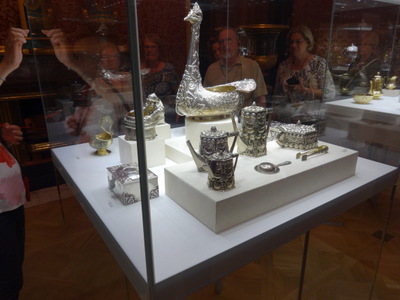
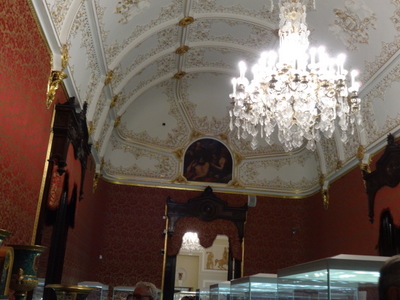 In the left-hand photo here, you can see a silver tea and coffee service, complete with a "biscuit barrel," presided over by a sterling silver hunchbacked dwarf. I think the large item in the center of the display is a kovsh and not part of the service, but I'm not sure.
In the left-hand photo here, you can see a silver tea and coffee service, complete with a "biscuit barrel," presided over by a sterling silver hunchbacked dwarf. I think the large item in the center of the display is a kovsh and not part of the service, but I'm not sure.
The ceiling and chandelier in the other photo is again part of the palace and not by Fabergé.
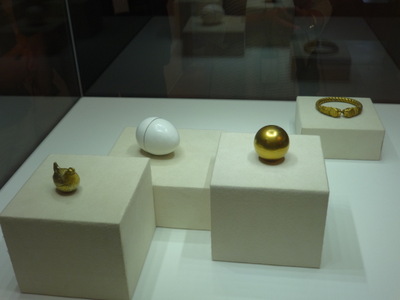
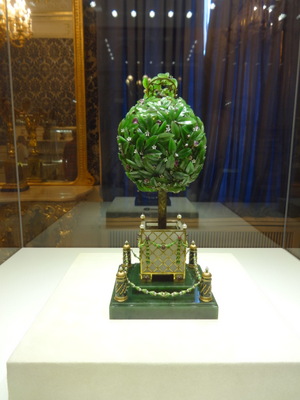 In 1885 Fabergé began making the objects for which he became most famous—decorative Easter eggs. Alexander III commissioned the first one that year as an Easter present for his wife, Dagmar of Denmark, and thereafter commission one each year until his death. The first one, the "hen egg," is shown here at the left. It opened to revealal the tiny gold hen inside. I'm not sure about the golden ball to the right of it. Perhaps the hen fit inside the ball, which in turn fit inside the egg. Keep in mind the miniaturization involved, though—all the eggs are life size.
In 1885 Fabergé began making the objects for which he became most famous—decorative Easter eggs. Alexander III commissioned the first one that year as an Easter present for his wife, Dagmar of Denmark, and thereafter commission one each year until his death. The first one, the "hen egg," is shown here at the left. It opened to revealal the tiny gold hen inside. I'm not sure about the golden ball to the right of it. Perhaps the hen fit inside the ball, which in turn fit inside the egg. Keep in mind the miniaturization involved, though—all the eggs are life size.
Alexander III died and his son Nicholas II (yes, last of the Romanovs) was crowned in 1896. He continued the tradition, but because his mother was still alive, he commissioned two eggs per year, one for his mother and one for his wife. The "bay tree egg" at the right was his 1911 Easter gift to his mother. It incorporates 325 individual leaves, and it is opened with a key. The lid pops up (as shown here) to reveal a minute bird, covered with real (minute) feathers that sings a tune. The bird is hard to see against the underside of the lid in this shot, but you can make out all the little flowers and fruit on the tree. It incorporates gold, diamonds, rubies, nephrite, rock crystal, amethysts, citrins, and pears, in addition to the feathers.
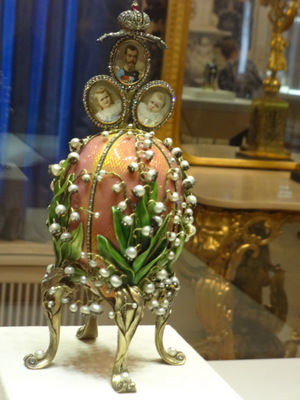
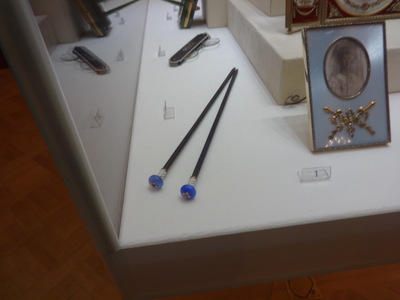 Here's my favorite of the eggs—the lilies of the valley egg, Nicholas's 1898 gift to his wife. It also opens with a key, and the three miniature portraits (of Nicholas and their first two children) pop up. Each of the protraits is an actual original oil painting. The egg incorporates gold, diamonds, ruby, pearls, ivory and glass.
Here's my favorite of the eggs—the lilies of the valley egg, Nicholas's 1898 gift to his wife. It also opens with a key, and the three miniature portraits (of Nicholas and their first two children) pop up. Each of the protraits is an actual original oil painting. The egg incorporates gold, diamonds, ruby, pearls, ivory and glass.
And when you're an empress, you can even have your knitting needles made by Fabergé, these are made of gold, rubies, wood (the actual needles), and smalt (glass colored blue with cobalt) and entailed engraving, carving, and champlevé enamel. Fabergé and his minions came up with 144 different tints and shades for enamel. "Guilloché" machines are used for making geometric patterns in enamel, and somewhere, we toured a museum with a fantastic exhibition on the origin and workings of guilloché, but I'm darned if I remember where . . . .
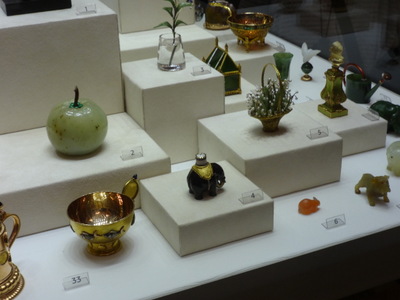
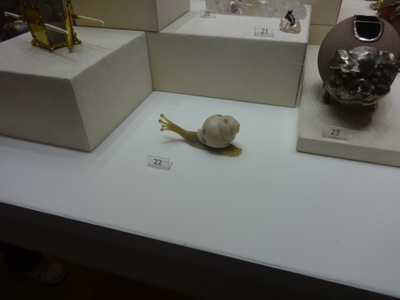 The company apparently also made little carved stone objects, sort of like netsuke. Here we see, for example, an elephant (probably a perfume bottle), an apple, a little basket of lilies of the valley, a couple of birds, a miniature watering can, a bulldog, and a bunny.
The company apparently also made little carved stone objects, sort of like netsuke. Here we see, for example, an elephant (probably a perfume bottle), an apple, a little basket of lilies of the valley, a couple of birds, a miniature watering can, a bulldog, and a bunny.
At the right is my favorite, a translucent snail. Number 23, behind him at the right, is a piggy bank. Number 21 is a minute seal on a clear glass rock.
So what's the deal with the Fabergé eggs? Similar objects were commissioned by others, but the ones usually referred to as the Fabergé eggs are the ones commissioned by Alexander III and Nicholas II. Together, they ordered 51 in all, but the 51st was never completed, so we're talking about a collection of 50 eggs, all of which were originally the property of empresses Dagmar of Denmark and Alexandra Fedorovna.
After the revolution, they were nationalized, and in the 1920s and 1930, 40 were sold by the state treasury, which was desperate for foreign currency. Currently, 7 of the 50 are unaccounted for. The queen of English has 3. The Virginia Museum of Fine Arts in Richmond has 5 (bequeathed in 1947 by a collector named Lilian Thomas Pratt). Several are in private collections. Wikipedia lists all the known locations in excrutiating detail.
Most recently, a scrap-metal dealer in Wisconsin bought one unawares in 1960 for $600 and couldn't manage to sell it for $800. He held onto it, and when the internet came along, he searched for information, starting from the brand name on the clock embedded in the egg, and turned up an article in The Telegraph that showed a photo of his very egg! He called the author, who was working for Swarovski in London and said he thought he had the egg in the photo. Swarovski actually flew someone over to to look, who spotted it instantly as a Fabergé. Swarovski bought it (for rather more than $800) and exhibited it in London before selling it to an anonymous collector.
The museum now exhibits 3000 FAbergé items. It bought its eggs from Malcolm Forbes, who thought he had 11 of them—one more than the 10 in the Kremlin armory—but two proved to be fakes.
On the bus ride back to the ship for dinner, Alexei gave us more detail on the Fabergé family. Gustav's son Carl was head of the business in 1917, and he was the one who decided it ws time to get out. He closed the place down in March of that year and moved to Lausanne. He tried working a little there, but he died in 1920; his children decided to bury him in the Russian cemetery in Nice.
Carl had four children: Alexander, Eugene, Nicholas, and Agafon. Alexander and Eugene joined their father in Lausanne. Nicholas hadn't lived in Russia since 1903; he'd been running the Fabergé shop in London. Agafon stayed in St. Petersburg and was arrested in 1918. A few months later, the treasury department realized they had nobody who could appraise all the stuff that now belonged to the government, so they took him directly from jail to the Moscow Krelim, where he worked as appraiser of state treasure. Sales were difficult, and some claimed Agafon was giving false information to discourage buyers, and he was arrested again. Connections in the French embassy arranged for him to escape. He packed only the bare essentials and walked three miles over the from St. Petersburg to Finland with his wife and son Oleg. He had already prepositioned his excellent postage-stamp collection in Helsinki, where he sold it off gradually for money to live on. Their descendents still live there; you can see their graves.
In Lausanne, the family didn't do as well as they had in St. Petersburg.
Fabergé & Co. was registered in France. In the 1950's, Faberge, Inc., was registered in the US by Samuel Rubin, a friend of Armand Hammer. F & Co. sued F, Inc., and settled by selling use of the name to F, Inc. F, Inc., still exists but is owned by Unilever; they franchise the name out to jewelry companies on short-term contracts. The London shop closed in 1917. Nicholas had an illegitimate son, Theo, with the secretary of the shop, Doris Kalditch. They split up right after the birth of the child, and the mother never revealed to the child who his father was. When Theo found out at age 40, he began studying jewelry making and trying to relaunch the whole enterprise. In the 1980's he opened a Fabergé house in New York and makes wooden eggs.
Written 27 September 2017

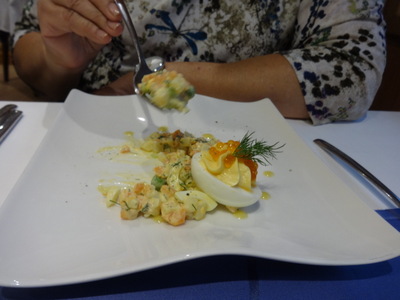 Then it was back to the ship for dinner. I think this was the occasion on which Rachel ordered all four appetizers—I know there was one such occasion. And good ones they were, too. I had the "creamy mushrooms with crisp puff pastry pillow," and for once it really was crisp!
Then it was back to the ship for dinner. I think this was the occasion on which Rachel ordered all four appetizers—I know there was one such occasion. And good ones they were, too. I had the "creamy mushrooms with crisp puff pastry pillow," and for once it really was crisp!
The right-hand photo is of the "Russian stuffed egg with vegetable salad and red caviar."
I didn't get a photo of the "cream of corn soup with whipped cream with aged whiskey."
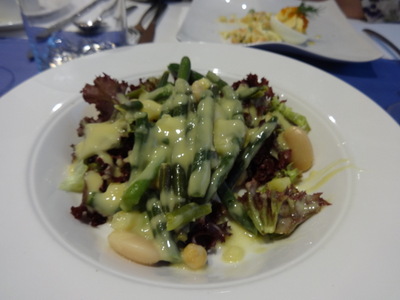
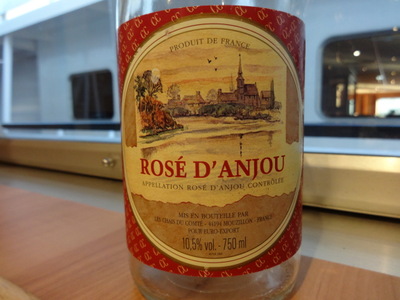 The fourth choice was "three bean and Lollo Rosso salad with garbanzo, scarlet runner, green beans, red onions, pineapple, shallot vinaigrette." Lollo Rosso is the particularly good variety of ruffled red lettuce used in the salad.
The fourth choice was "three bean and Lollo Rosso salad with garbanzo, scarlet runner, green beans, red onions, pineapple, shallot vinaigrette." Lollo Rosso is the particularly good variety of ruffled red lettuce used in the salad.
At the right is the bottle of wine we won in the movie trivia contest. Ev, Rachel, and David shared it over this meal. Behind it is our dining room window, and behind that are the dining-room windows of whatever Viking ship was inboard of us that night; they shuffled positions every day.
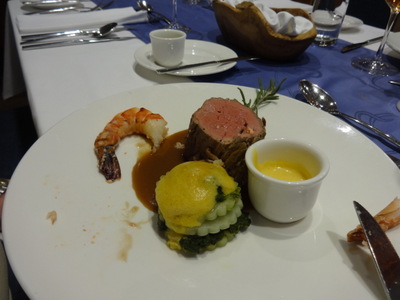 For the main course, we all had the roast beef tenderloin steak and grilled jumbo shrimp with potatoes, spinach, bé'arnaise sauce, and red wine jus. Nobody ordered the fillet of salmon with cilantro sauce or the Asia vegetable curry.
For the main course, we all had the roast beef tenderloin steak and grilled jumbo shrimp with potatoes, spinach, bé'arnaise sauce, and red wine jus. Nobody ordered the fillet of salmon with cilantro sauce or the Asia vegetable curry.
For dessert, everyone else had the "hot chocolate fondant cake with chocolate sauce and whipped cream. I couldn't face that after a heavy meal, so I had the raspberry sorbet. And by golly, I had the caramel sauce on it; not an obvious combination, but it was actually pretty good.
The evening's entertainment began with a short "final farewell" speech by Margo, who quoted us some statistics compiled by the ships comptroller. Collectively, on this cruise, we consumed 150 steaks (we thought that was low; maybe it was 150 cases of steak?), 200 shots of vodka (that sounded really low; they must have gone through that many at the vodka tasting alone; maybe it was 200 bottles of vodka?), and (this one I'd believe) 20 km of toilet paper.
Margo then introduced two soloists from the Mariinski Theater, Carlos D'Onofrio, a tenor from Buenos Aires, and Maya DiAnn Krivchenia, an American soprano (and the Mariinski's English diction coach), who had come to entertain us, together with their Russian accompanist, Ekaterina Venchikova. Each of the vocalists sang a couple of solos as well as a few duets:
Lenski's song from Eugen Onegin
An aria from La Bohème
A song by Tschaikovski, called Please, God, put me back on the earth
Something by a Soviet contemporary movie composer
On The Street Where You Live from My Fair Lady
Dark Eyes (I'd been waiting for somebody to sing that one)
A duet of The Merry Widow Waltz
A song from a 1940 Soviet musical film called A Musical Story
All excellent!